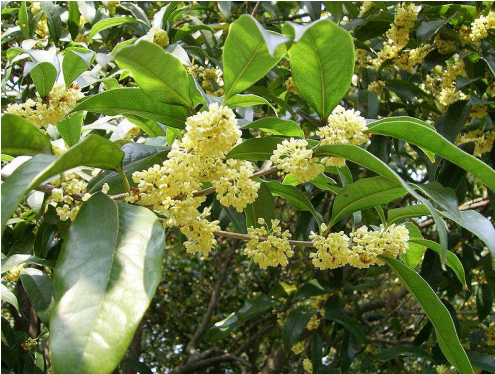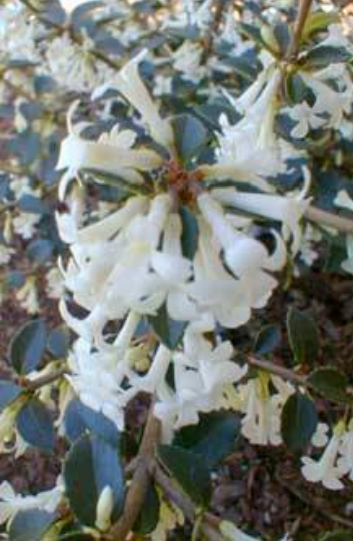OSMANTHUS
by Merylyn Condon
Commonly known as the Sweet Olive and originating in Asia (Himalayas, China and Japan), osmanthus produces clusters of tiny tubular flowers with a delightful fragrance. Osmanthus is to the Chinese what wattle is to an Aussie and is the focus of many a Chinese festival. In China, it is used to flavour teas and the extract from osmanthus fragrans var. aurantiacus (costing US $4000 per kg) is used internationally in the best perfumes. Historically, it had many other uses in south east Asia as a hair decoration, dried and kept in jars for its scent, flavouring wine, jam and medicine, and the bark used for dye and the timber for carving.

Osmanthus fragrans
Osmanthus fragrans grows to 6 – 18 ft. The tiny white flowers are extraordinarily fragrant and appear in small insignificant clusters along the twigs in spring to early summer. Osmanthus fragrans var. aurantiacus is an orange-flowered form and both are well worth growing and often seen at garden centres.
Osmanthus heterophyllus. The glossy leaves of this species are quite holly-like, though smaller than holly leaves. Tiny white clusters of perfumed flowers appear in early winter. I particularly like Osmanthus heterophyllus ‘Purpureus’, because the young shoots and leaves have a dark polished tint almost like the copper beech, but the purple tint is temporary, and as time passes the leaves transform to dark, glossy green. A variegated form, o. heterophyllus ‘Variegatus’ is also worth growing. A new introduction is O. heterophyllus ‘Goshiki’. Goshiki means ‘five colored’ in Japanese and refers to the cream, pink, orange, yellow, and white colourings on the leaves. My plant is quite young, and so far only shows green and gold colouring, but I have high hopes that one day it will live up to its name!

Nowadays you can find smaller growing osmanthus, so even those with tiny gardens can enjoy the scent of osmanthus in the air. One such plant is Osmanthus delavayi “Heaven Scent






